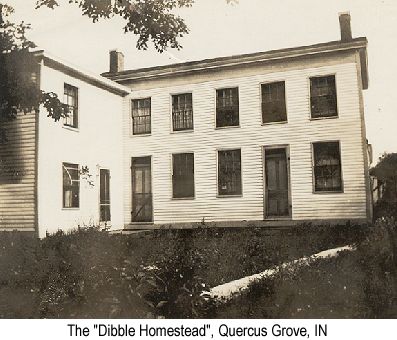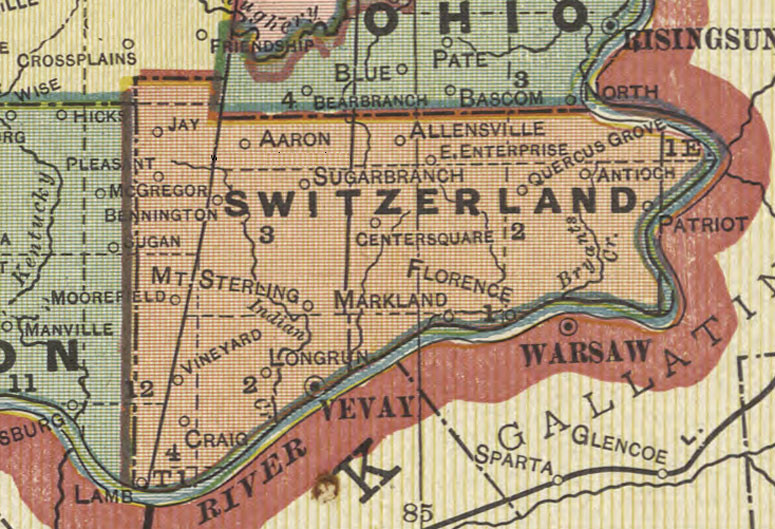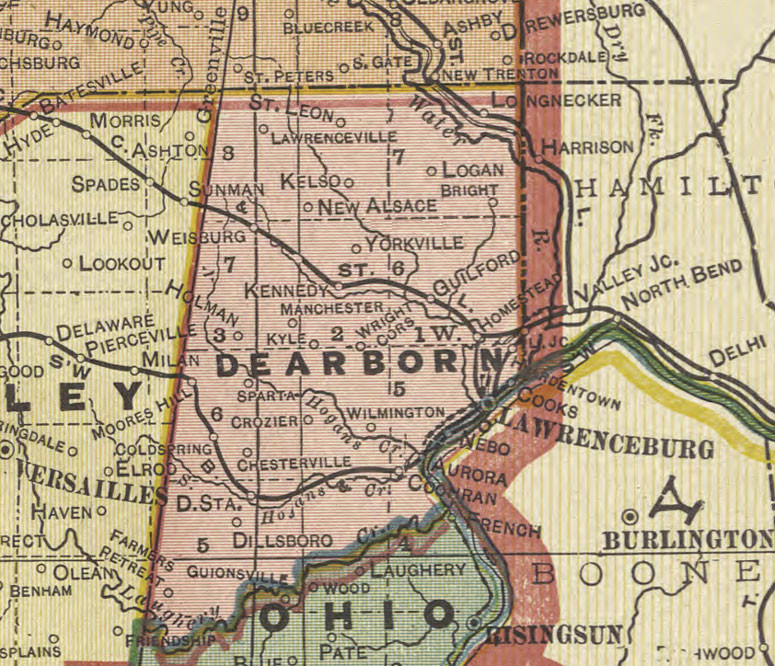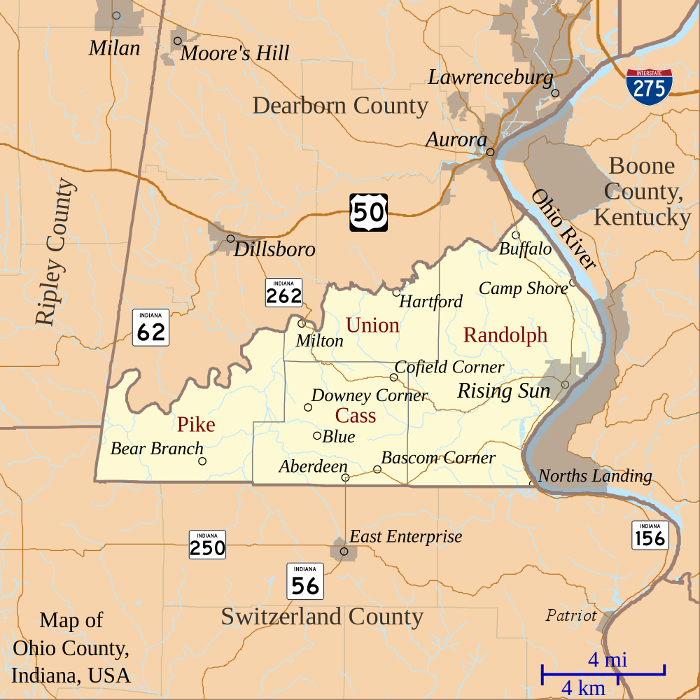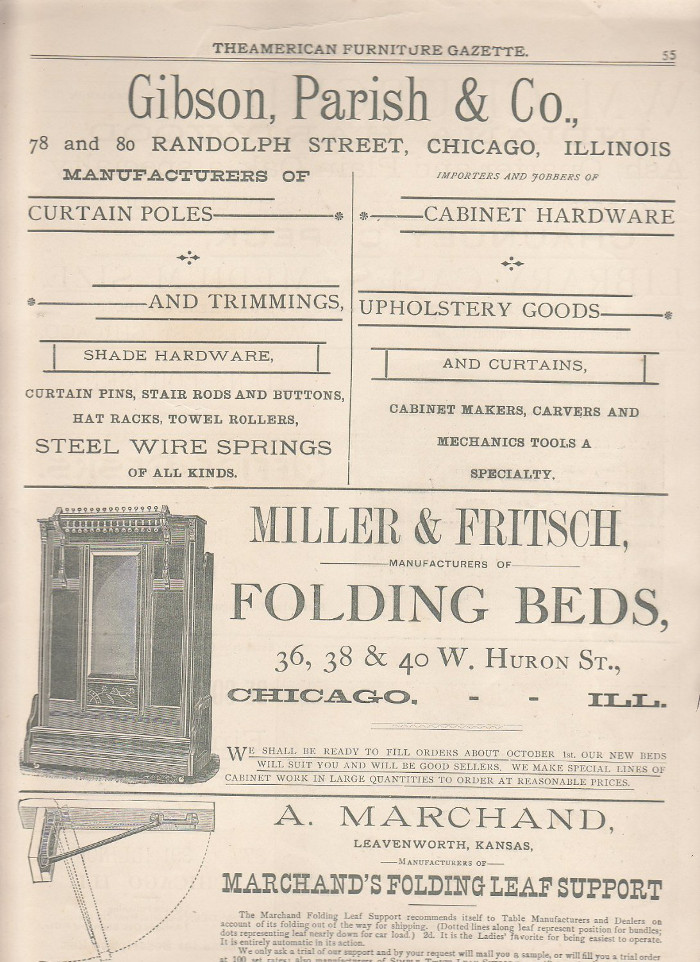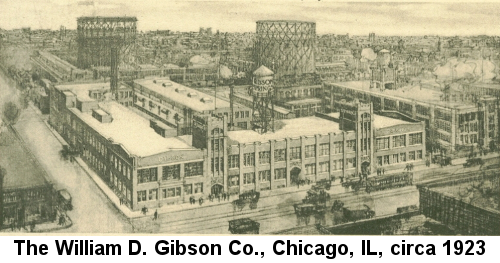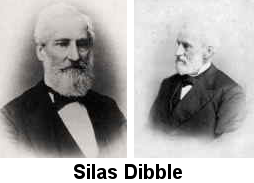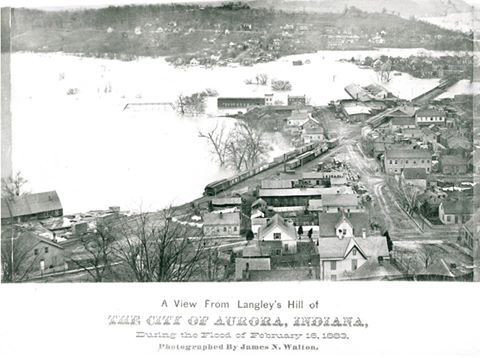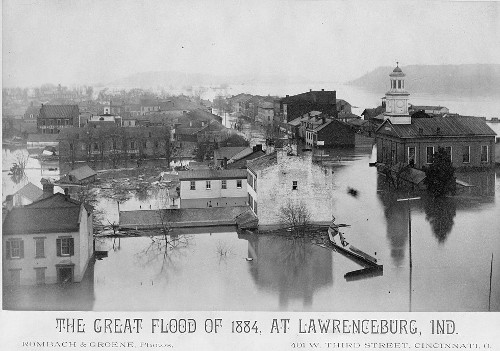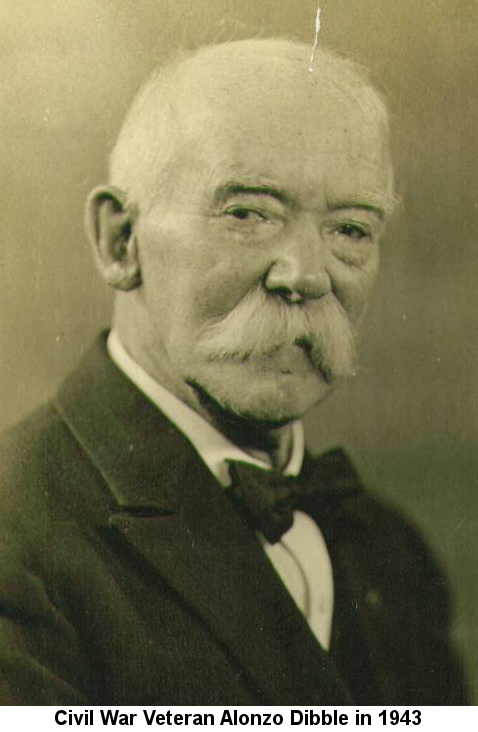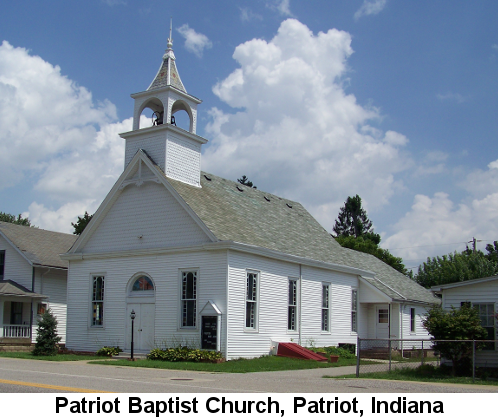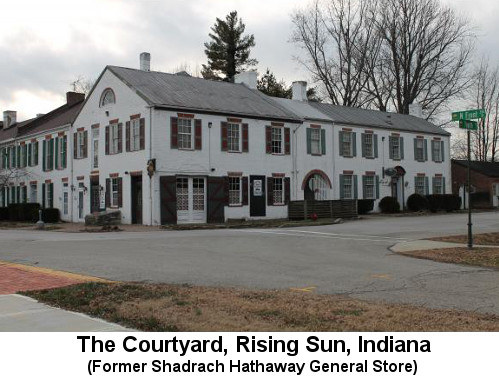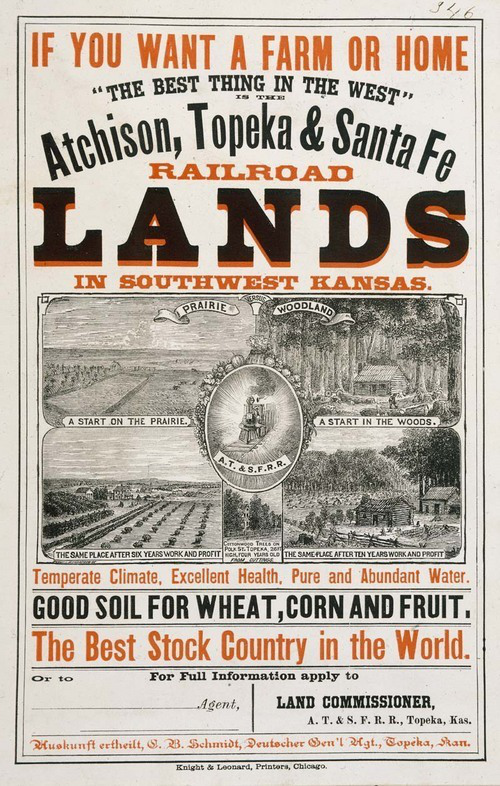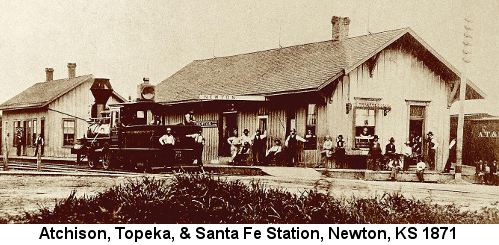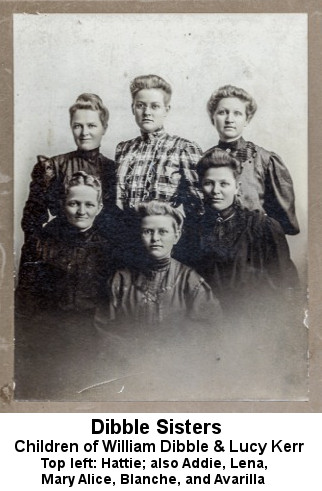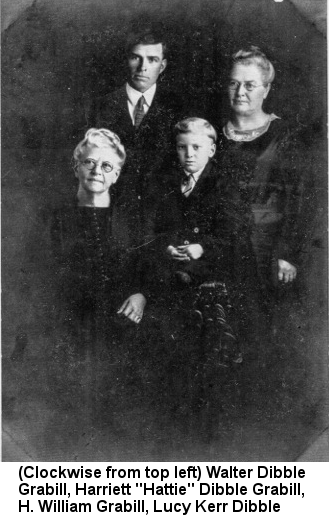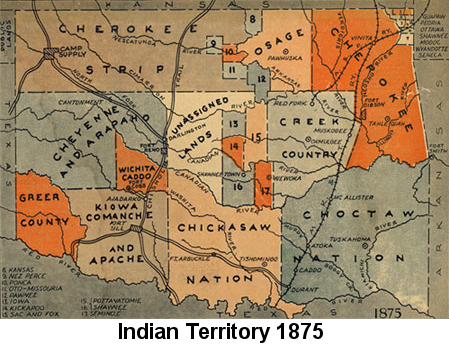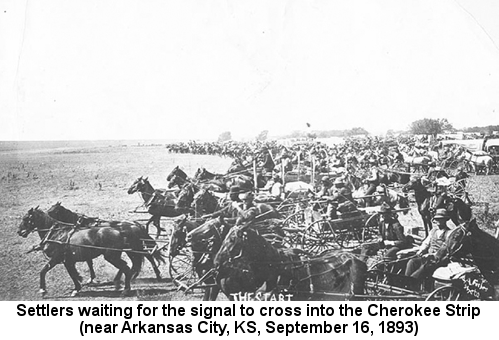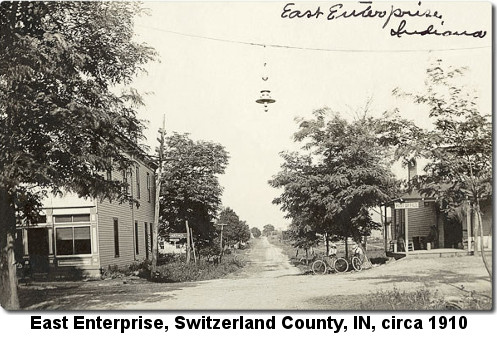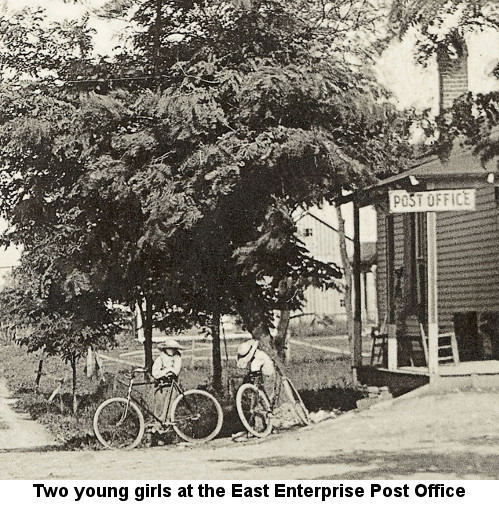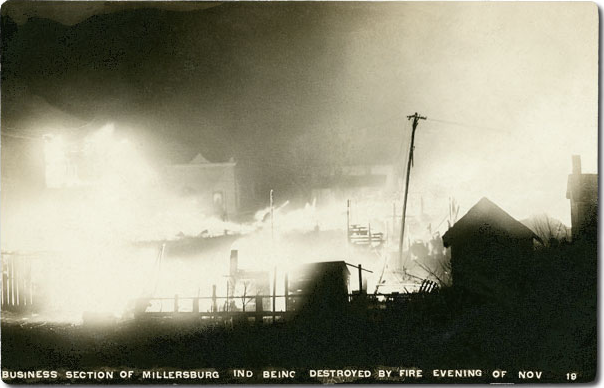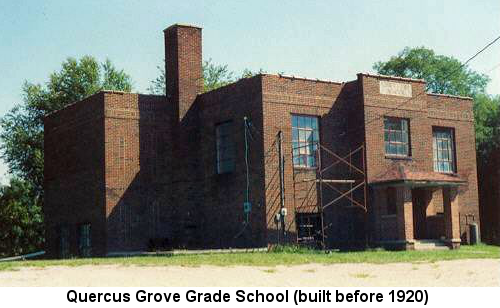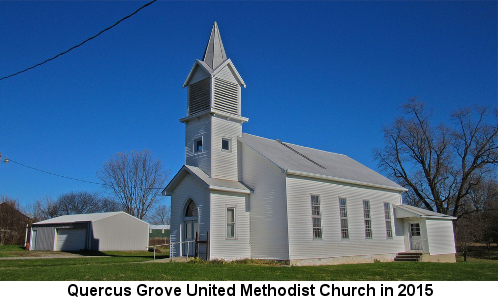
Here we take up the stories of the descendants of Samuel Dibble of New York, and John Dibble of Connecticut, who came to southeastern Indiana in the 1830s but did not move on to Minnesota.
Samuel Dibble's Family from 1832 Onward
As we detailed in The Colonial Years, Samuel Dibble, son of George Dibble, grandson of Lt. Jonathan Dibble of Stamford, CT, probably lived out his life in North Castle, New York.
Samuel Dibble's second wife Deborah Ingersoll was buried in Patriot Cemetery in Switzerland County, Indiana, so we know she joined the family trek westward, perhaps after Samuel's death. However, her gravestone is broken off just at the death date, so we don't know when she died, nor do we have information about her life in Indiana.
George Dibble, son of Samuel and Deborah, was born in New York in 1805, probably in the month of May. He may have come to Switzerland County as early as 1832. The earliest-known Dibbles settled in Davis' Corner, just east of Quercus Grove in Posey Township, where George's uncle John bought a farm.
On September 13, 1838, George married Mary Monroe in Switzerland County. Mary's father was Henry Monroe and her mother was also named Mary. They had these children while living on a farm there:
Henry M. Dibble, born in 1840
Edward Jason Dibble, born January 11, 1842
Jane Dibble born around 1844
Emely Dibble born about 1847
John Dibble, born in May 1850
George was probably pretty well-known in Posey Township, at least well enough that people called his younger cousin George "Junior" to tell them apart.
Mary's father Henry Monroe knew he was dying in the late summer of 1846, so he wrote out his last will and testament, which was witnessed by George's "junior" cousin. Henry left Mary and three of her sisters 39 acres of land. We don't know what use, if any, Mary and her husband made of her share of this bequest. At some point after 1850, George and his family moved to Illinois.
They settled in Randolph Township in McLean County, in the center of the state, just south of the village of Heyworth. There they had more children:
George Dibble, born around 1853
William M. Dibble, born in July 1856
Ann Dibble, born around 1859
Their daughter Emely may have died before reaching adulthood.
Edward enlisted in Company B of the 94th. Illinois Infantry in August of 1862, and served with that outfit until May 1865. The 94th. Illinois, known as the "McLean Regiment" for reasons that should be obvious, participated in the Siege of Vicksburg, and in various minor battles.
Henry M. Dibble married Sarah Elizabeth Cunningham. Their children were:
Harriet Della Dibble, born in 1867 in Illinois; died 1901
James Delbert Dibble, born in 1869 in Illinois; died 1920
Amy Jane Dibble (1874-1915)
Viola Ruth Dibble (1882-1967)
George and Mary's son Edward married a woman named Mary, born in around 1846, probably in the late 1860s.
George and Mary's son George married Sylvia A. Ellis, known as "Lyva", also of Illinois, who was born in 1854, sometime before 1880.
Most or all of the members of the George Dibble family moved to Bates County, Missouri, though perhaps not all at the same time. The move didn't really bring good luck to any of them.
Edward's young wife Mary died there on August 27, 1872. George and Lyva's daughter Daisy was born there in around 1878.
George and Mary's son William married before 1880, and his wife, whose name is unknown, probably died while bringing their son Charles into the world in May of that year in Bates County.
In that same year George the younger, with wife Lyva and daughter Daisy, were living in New Home Township in that county.
George the elder died before 1880, and we don't know when or where, although one undocumented source gives the year as 1870 and the location as Bates County. In 1880 his widow Mary was living with her widowed sons Edward and William, and her unmarried son John, in Lone Oak Township in that county. The same undocumented source has her dying later that same year. We don't know what became of the daughters Jane and Ann.
On December 15, 1882, in Bates County, Henry was "killed when a load of firewood rolled on him." His widow Sarah may have remarried, to a man named Gambrel.
Edward definitely remarried, to Brittie Hancock. She was born on August 3, 1865, the daughter of Fayette Hancock and Nancy Thomas. We don't know when this marriage took place but it most likely would not have been before the mid-1880s. Edward died on April 7, 1899. Brittie died on August 12, 1942, one of the last surviving widows of Civil War veterans.
William also remarried, in around 1883. His bride was Mary Alice Callaway, born in April 1858 in Missouri. Their son George was born in September of that year. They had a second son, Tony, on October 21, 1889, and their daughter Edna was born in 1897. Tony married Julia C. Brooks (1893-1962). Tony died on October 15, 1972. William's second wife died in 1938, and he followed her in 1946.
George Dibble the younger died on May 6, 1921. His wife Lyva died on April 18, 1928.
Perhaps the saddest of all of these sad stories is that of the elder George Dibble's son John. He never married, never learned to read and write, and he spent at least ten years living in the Bates County "poor farm" or "alms house". He died on April 24, 1919.
Harriett Dibble, daughter of Samuel and Deborah, was an active community member in Patriot, Switzerland County, from almost the moment she arrived there. In 1835, at around the age of 31, she was one of the founding members of the Universalist Society of Patriot. Universalism at that time was a version of Christianity distinguished by two fundamental beliefs: that all souls would eventually be reconciled with God, and there is no place of eternal punishment, or "hell", in the afterlife.
On August 23, 1837, Harriett married William Gibson. William was born in New York City on August 28, 1801. He was a successful merchant in Patriot.
William and Harriett had these children:
Isabella "Belle" Gibson, born December 5, 1839
Thomas Ingersoll and William D. Gibson, twins born on April 4, 1841
In 1850 another 9-year-old child, Frances Hait Gibson, was living with the family; she may have been a niece of William.
In 1852 William became the Postmaster of Patriot. He must have done a good job because he was re-appointed to the position in 1861.
William and Harriett's son Thomas died of an accidental gunshot wound at the age of 15, on December 7, 1856.
In the 1860s William Gibson's dry goods store occupied the first two floors of a three-story brick building in Patriot. The location is unclear; as a result of several devastating floods and at least one major fire, today's Patriot is quite a bit different from the town of Civil War times. The best guess is that it stood somewhere between Third and Fourth Streets along a section of Front St. that no longer exists.
William's son William D. Gibson, sometimes called "Junior", worked with his father as a clerk in his store until the Civil War came. He registered for the draft in June of 1863, and he served briefly on a Union navy gunboat later that year.
William Sr. died on December 14, 1863 and is buried in Patriot Cemetery. It may be that William Jr. was released from the Navy so he could return home to take care of his widowed mother and dependent sister. In any case, he was back in Patriot by January 1864, when he was given his father's job as Postmaster. But he was destined for greater things.
By 1870 William Gibson Jr. was working as a bookkeeper in Chicago. He lived with his widowed mother Harriett and his still-single sister Isabel in the 10th. Ward, just west of the Chicago River--and also west of the areas that were destroyed the following year in the Great Chicago Fire. It was a large household, including Francis M. Ives, another bookkeeper; Edna Ives, "Boarder"; Edward S. Shepard, a traveling salesman; and Donald McLean, a wood engraver. Perhaps William was keeping a boarding house, or perhaps these people were part of his new business.
Not much later, William married Gertrude L. Mitchell (she was born December 16, 1846). Their first daughter, Julia B. Gibson, was born in around 1874.
In 1880 William, his mother, and sister were all still living together. By now though, the crowd of unrelated people was gone, and William had moved up from "bookkeeper" to "hardware man". That same year, he and Gertrude had a daughter, Isabella, who may have died as an infant. On May 5, 1882, their daughter Elsie was born. This child lived less than 8 months, and died on Christmas Day, 1882. William's mother Harriett died on Februay 21, 1884.
William was probably the co-founder of what became the Wm. D. Gibson Co., a major manufacturer of springs for beds and other uses. The company originated as Gibson, Parish & Co. in Chicago before 1884. In 1888 it was located at 78-80 Randolph St. in Chicago, on the boundary between the old 9th. and 10th. Wards, near where William lived. The company manufactured cabinets, curtain poles, and other hardware for curtains and shades, various kinds of springs, and curtains and upholstery-related goods. On March 1, 1889, the building was totally destroyed by fire. However, according to The Iron Age, "the stock was worth about $140,000" and "The insurance amounted to about $135,000 ... It will be seen, therefore, that the firm will be able to resume business without any difficulty as soon as they can find a suitable location." In the meantime, the company set up a temporary office on the second floor at 84 Washington St.
Silas Howe, a Civil War veteran from Patriot, moved to Chicago to work for the company, and eventually became president of its successor, the Wm. D. Gibson Co. This Silas was the grandson of the "father of Patriot", Sylvanus Howe, and a great-grandson of Silas Howe and Abigail Fisk, who may have been the parents of Sarah, the wife of John Dibble of Connecticut. Two of the younger Silas' children, Warren Dibble Howe and William Gibson Howe, also worked for the company. William died in 1892, on December 5, and is buried, along with his mother Harriett Dibble, and other family members, in Rosehill Cemetery in Chicago. He never saw the stupendous factory the company built on Clybourn Avenue in 1908. Its two neo-gothic towers still stand there today, guarding a parking lot and housing small shops.
Samuel Dibble of New York had two sons named "Ingersol" or "Ingersoll". That in itself is not unusual; often if a child died young, a subsequent child of the same parents would be given the same name. But these two Ingersolls both lived to adulthood.
Ingersoll Dibble (1) was born on the 16th. of some month in 1801 in North Castle, NY. He died in 1834, two years after the first Dibbles came to Indiana, and is buried in Patriot Cemetery.
Ingersol Dibble (2) was born around 1814. In 1840 he was living in Posey Township in Switzerland County with his wife Catharine, who was born in around 1811. Also in that year, on April 2, he was appointed as one of 25 delegates to represent the township at the County Democratic Convention in Vevay later that month. He and Catharine may have had a son named Warren in 1841, and they had a son named John who was born in 1842. Some time before 1850, Ingersol, Catharine and John moved to Vicksburg, Mississippi. In Mississippi Ingersol was a riverboat pilot, the same occupation that Mark Twain pursued before becoming a writer. Some 13 years after that date, Ingersol's town would be visited by some of the other Indiana Dibbles, though not under friendly circumstances.
All we know about Warren Dibble is that, at around the age of 19, he was living with several unrelated young men in the household of J. R. Harris in Posey Township in 1860.
John and Sarah Dibble's Children from 1854 Onward
Silas Dibble, the full-time flatboat-man and his wife Mary Jane (Bunnell), who lived in Patriot, had two more children:
Samuel Jessup Dibble, born June 5, 1855, and Caroline "Carrie" Dibble, born October 29, 1860.
Silas became recognized as an expert on flatboats and served as an appraiser of them. In June 1856, for example, he appeared before a local judge to appraise "an Estray Boat... a Coal Barge ... one hundred and twenty feet long, twenty one feet wide, seven feet high, with six pieces spliced with iron bolts on each side; the bottom three inches thick--put on with iron spikes." Silas felt the boat was worth $200,000.
In 1863 Silas, like many of his neighbors, including other Dibbles, contributed funds to the Indiana Sanitary Commission. The state Sanitary Commissions were chapters of the United States Sanitary Commission, which was organized during the Civil War to support hospitals to care for wounded soldiers. They collected blankets, clothing, bandages, and food to send to the hospitals, and arranged for doctors, nurses, and orderlies to work in them.
Silas' daughter Mary Ann married Elmer DeHart on December 9, 1860 at the Methodist Episcopal Church. Elmer was born in around 1840. His parents were Simon DeHart (1809-1874) and Mary Ann Graham (1816-1887). The DeHarts were living in Switzerland County by 1840.
Shortly before his marriage Elmer lived in a hotel in the river town of Florence in the southeast corner of the county. He was a carpenter. In August of 1862 he joined the army (whether enlisted or drafted, we don't know) and served as a private in Company C of the 93rd. Regiment until April 1863.
Mary Ann and Elmer had two children:
Harvey Graham DeHart, born around 1863
Clarence DeHart, born around 1865
By 1870 the family had moved to Gallatin County, Kentucky.
Silas's son Harvey enlisted in the Army as the Civil War was getting underway, in August 1861. He served as a private with Company D of the 18th. Indiana Infantry Regiment as a "three year man". He was mustered out in August 1864. For more on his wartime experiences, see Indiana Dibbles in the Civil War.
When he returned from the war Harvey went into the butchering trade, working with a man named Zac. Not long after that he may have partnered with J. M. Scranton, a beef and pork packer in Patriot, to establish Scranton & Dibble's General Store. If so, the partnership didn't last long. The store had been sold twice by 1876.
Harvey married Maria Phipps on April 8 or 9, 1869. The Phipps family came from Leicestershire, England--perhaps from the city of Leicester itself--where Maria was born on September 9, 1847. Her parents were John Phipps, a tailor born about 1812, and a woman also named Maria, born about 1811, and they had another child, Caroline Phipps, born in about 1851. They were living in Aurora in Dearborn County, Indiana, on the Ohio River about 20 miles north of Patriot, in 1850. But something happened, and some time before 1860, young Maria was taken in by another British family, that of Army Surgeon Charles Edmon or Edmonds. The Edmonds lived in Patriot, where Maria met Harvey.
Almost immediately after their marriage, Harvey and Maria traveled to Crawford County, Illinois, which is just over the Indiana line, about halfway between Terre Haute in the north and Vincennes to the south. It's possible that Harvey was chosen by the wealthy landowner Sylvanus Howe to run a farm he had purchased there, near the town of Palestine. Howe accompanied Harvey and his wife to Illinois and stayed there with him for a while. Harvey worked as a farm laborer for Sylvanus, as did another young man, George Felah or Delah; George's wife Adaline lived with him on the farm as well. Later, when a member of Sylvanus's family, also named Sylvanus, was old enough, he came out and took his father's place on the farm, and the elder Sylvanus returned to Indiana.
On May 30, 1871 Harvey and Maria's first daughter, Adelaide ("Addie") May, was born in Illinois. The family was back in Indiana by March 11, 1874, when their second daughter, Caroline, was born. On May 11, 1878 the couple had a third daughter, Mary E. Dibble.
By 1880 Harvey had his own meat market in Patriot. Like his uncle Charles, he was a member of the International Order of Odd Fellows. He was also a member of the Patriot Methodist Church.
The decade following the Civil War was probably the high point for the town of Patriot. It certainly was much larger then than it is now.
But the years 1882, 1883, and 1884 were disastrous for the people who lived along the Ohio River bend. Each year saw terrible floods, with 1884 being the worst, a catastrophe that wiped out most of the business district in Patriot, severely damaged Florence, and caused untold death and suffering in Lawrenceburg up in Dearborn County.
As reported in The Great Flood of 1884 in the Ohio Valley, edited by John L. Vance:
"Rising Sun was one of the 'high and dry' towns. It was the incentive to much pride and congratulation during the flood. All the country between the town and Arnold's Creek Bridge, however, was a flooded district. Not more than twenty-five or thirty houses in the town got into water, and they in the lower part of the city. Patriot, Ind., was submerged, and suffered greatly. ... Nearly the whole town of Florence, Ind., was submerged, and some of it very deep. Nearly all the surrounding country was flooded, and it was found necessary to send much aid there. Vevay sets back from the river and on quite an elevation; still a good portion of the city got her foot into it. Lots of the inferior houses, in what is known as Slabtown, were washed away."
The flood may have wiped out Harvey's business. The H. Dibble meat market seems to have disappeared from history, and local memory, at this point.
But Harvey and Maria forged on, and their fourth child, Nina, was born on May 12, 1886.
Their daughter Addie May married William Rea of Patriot, a craftsman who made willow baskets and furniture, on February 8, 1891. He was born in January of 1866. Addie died on September 14, 1944 in Patriot.
Right around this time a second disaster struck Harvey along with most of his neighbors. The Panic of 1893, the worst financial downturn in the United States between the Panic of 1837 and the Great Depression of the 1930s, may have diminished his spirit. He does not seem to have worked as a butcher or a merchant from this time onward.
Harvey and Mary's daughter Mary married William Cook on July 1, 1896 in Indiana. They had many children, and at some future point a revision of this website may provide more details on them. Mary died on May 29, 1942, somewhere in rural Switzerland County.
By 1900, Harvey was working as a laborer and Nina was in school. Their first daughter, Caroline, known as "Callie", was single and living with them; she worked as a seamstress. Also in the household at that time was Harvey's sister-in-law, Caroline Weber.
In 1906 Harvey and Maria acquired the house his father Silas had owned in Patriot from Daisy and William Vogt, probably when they moved to Cincinnati.
Also in 1906, on January 24, Harvey and Maria's oldest daughter Callie married John Starker, a farmer, in Hamilton County, Ohio, the location of Cincinnati. He was born on August 2, 1874. Callie died later in 1906, a tragedy about which we know nothing more. If she died in childbirth, we have found no record of children of this marriage. John Starker appears to have remarried and moved to Michigan, but he returned to Indiana at some point and died in Aurora, Dearborn County, on June 12, 1948.
Harvey was 66 in 1910 but still active, doing "odd jobs" for people in the neighborhood. Nina was grown up but still single and living at home; she had a job as a saleswoman in a dry goods store in Patriot.
In 1914 spry old Harvey got written up in the Vevay Reveille for an endeavor with William Cook, "raising watermelons on the E. E. North farm in Mexico Bottom." Mexico Bottom is along the Ohio River in the northeast corner of Switzerland County, not far from North's Landing in Ohio County.
Harvey's wife Maria died on February 17, 1917. She was buried in Eastview cemetery in Patriot.
In 1920 Harvey was calling himself retired. Nina, still single but now working as a telephone operator, lived with him.
Nina married Edward Charles Cook, known as "Sparky", on March 27, 1926. Edward was a farmer, born on March 20, 1882; perhaps he was related to Harvey's old watermelon-growing crony. 1930 found the married couple living with Harvey in Harvey's house in Patriot.
When Harvey died on August 3, 1933, he was the last remaining Civil War veteran in Posey Township. He was buried in Eastview cemetery. Harvey's (formerly Silas's) house went to Nina and Edward, who kept it until 1937.
Silas Dibble's son John Joseph Dibble enlisted in the 18th. Indiana Volunteers, like his brother Harvey. But John seems to have had a talent for organization, and he was almost immediately promoted to sergeant. Jesup says he was an "orderly sergeant", or the top non-commissioned officer in his unit. He had training and administrative duties, and in battle he would have been responsible for getting orders from the officers distributed to the men. You can read about his wartime service here.
John came home from the war in August, 1864. A letter from his brother Alonzo, serving on a Union gunboat in September, suggests that their mother believed John may have had plans to migrate and settle elsewhere. Jesup reports that "after the war he went to Arkansas, where he was assassinated." Nothing else has been found about his life.
Silas's daughter Elizabeth (sometimes called Helen or Helen Elizabeth) had just turned 17 when she married William Pate on June 24, 1864, before a justice of the peace in Dearborn County.
William was born on July 28, 1839, and may have been a son of William T. Pate, founder of the W.T. Pate & Co. distillery in Patriot. His brother may have been Jackson Pate, whose daughter Louella we will meet later. There were several Pates in the region, some of whom were descended from two brothers who came from Virginia as children. William may have served as a captain with the 140th. Indiana infantry regiment after he was married, in the late stages of the Civil War, from October 1864 to July 1865.
Elizabeth and William moved around quite a bit. Their first child, George, was born in around 1866 in Indiana. Their second, a daughter named Rebecca, was born around 1867 in Kentucky. And by 1870 they were living in Heaths Creek, Pettis County, Missouri with a third child, Silas, just 7 months old. The Missouri farm was probably fairly large. Along with the Pate family, there were four men living on the farm and working as laborers. Two of these were brothers, one of them married with two children. The fourth was Elizabeth's brother Alonzo, the former Navy gunboat sailor.
In January 1874, they were back in Indiana, where their son Taylor W. Pate was born.
By 1880, the family had moved back to Kentucky and were living in Locust in Carroll County. Locust is a crossroads on Locust Creek about a half mile from the Ohio River and about ten miles from Vevay. There they may have spent time with Elizabeth's cousin Grace Dibble Lostutter and her husband Marion (Grace was a daughter of Elizabeth's uncle George). In 1881 Elizabeth gave birth to another daughter, Mary, and in 1883 her son William T. Pate was born.
The turn of the century found them in Garden City, Kansas. Their son Taylor was still living with them, but the other children had moved on.
Indiana became the final resting place of both William and Elizabeth. William died on March 14, 1906. Elizabeth followed him on December 13, 1907. They were laid to rest in Eastview Cemetery in Patriot.
Silas Dibble's son Alonzo Dibble loved boats, a natural interest for a boy growing up in the bend of the Ohio River. The story goes that Alonzo, his brother Willard, and a neighbor boy "ran off" to join the Navy even though they were all underage. We know that Alonzo enlisted in the US Navy on June 20, 1864, at which time he was 15. Willard, however, would have been 11. It's possible that Alonzo could have lied about his age and fooled a credulous recruiter; there are other reports of drummer-boys and so-forth getting into the Civil War armies at that age. But a child of 11 would clearly have looked like a child. Plus, history has not kept any Civil War military records on a Willard Dibble from Switzerland County, Indiana. It may be that Willard tagged along and tried to enlist but got patted on the head and sent home.
Alonzo liked to tell a couple of stories about his Navy days so often that they made it into his obituary. He said he acquired a hernia when he slipped on a narrow plank while carrying a sack of coal onto a ship. Then, one day while cruising down the Ohio River, he boasted that he was a good shot with a rifle. One of his shipmates challenged him to a contest. A sailor had spotted a pile of apples on the river bank with a spyglass. He and his shipmates taunted Alonzo about his boast. Alonzo took the rifle and shot the top apple cleanly in two, and said, "I shouldn't have to prove that again!" He later admitted the shot was pure luck.
You can read more about Alonzo's naval exploits here.
Alonzo was discharged from the Navy on June 21, 1865. We don't know what he did when he got home from the war, but by 1870 he was working as a farm laborer on his sister Elizabeth's farm in Missouri.
In 1872 he was back in Switzerland County, where he married Mary Lena McHuron on September 17. Mary was born on June 8, 1854. Her parents were Alvin McHuron and Elizabeth Hall.
Alonzo's trade was "tinner", or tinsmith, but the work he did falls within today's occupational categories of "sheet metal worker" and "steam fitter". He may have learned this in the Navy, where tinners worked on the steam engines, and the sheet metal used for armor plating, on the "tinclad" river gunboats. In civilian life he may have worked on commercial riverboats, or he may have made gutters and flashings for roofs. That being said, he was listed as a "merchant" in the list of "patrons" who sponsored the publication of A. T. Andreas's Illustrated Historical Atlas of the State of Indiana in 1875. His uncle Henry Sr. was also a sponsor.
Alonzo and Mary's first child, Abbie Alice Dibble, was born on July 2, 1873, in Patriot. The couple was also involved in a rather strange real estate transaction in that year. The house belonging to Alonzo's father Silas was deeded, or perhaps sold, to Alonzo's brother Harvey and his wife Maria, and to Alonzo and Mary, together as a group. Later that same day, the house was sold/deeded back to Silas' wife Mary Jane. Harvey and Maria may have returned from Crawford County, Illinois by then, but all in all, this sounds like a bit of trickery to solve a tax problem.
Alonzo and Mary had two more children in Indiana:
Alvin Matson Dibble, born December 11, 1874, in Florence.
John Hall Dibble, born on February 22, 1877, in Patriot.
The couple moved to Loveland, Ohio, about ten miles northeast of Cincinnati, sometime after 1880. There, on March 16, 1885, their daughter Lela Claire Dibble was born.
Sometime after 1890 Alonzo moved Chicago. He plied his trade there for US Steel at 79th. and South Shore Drive and in other steel mills until some time after 1910. Then he returned to the roofing industry. Alonzo always had a pocketful of wintergreen and spearmint candies for the grandchildren. He was a "stalwart member of Grand Army of the Republic", and he marched in the Memorial Day Veterans Parade in Chicago every year.
At least he did until about 1927, when he and Mary moved to Detroit, where he was visited by a Minnesota Dibble descended from his grandfather John named Willis Dibble. (Alonzo's daughter Lela struck up a correspondence with Willis' brother, Willard Dibble Sr., that lasted until the latter's death.) In 1930 Alonzo and Mary were renting a house on Fullerton Avenue in Detroit, and in 1937 they were on Mendota Ave. Sometime that autumn, Mary banged her ankle against something, and the injury became infected. She got "blood poisoning", or septicemia, and died of it on October 28.
Mary was buried in Chicago. Perhaps that's when Alonzo returned there. It's where he died, on April 29, 1943, and where the proud old Union riverboat veteran was laid to rest, next to Mary, in Evergreen Cemetery.
On October 20, 1892, Alonzo's daughter Abbie married Isaac N. Cushman in Hamilton County, Ohio. Isaac was born in November, 1869. Their first daughter, Martha May Cushman, was born in October 1894, and their first son, Joseph Dean Cushman, was born in January 1897. Isaac was a telegrapher.
Not long after that, the Cushmans moved to Adams Township, in Decatur County, Indiana. Their daughter Edith V. Cushman was born in around 1901. Two years later, their son Ores Cushman was born.
The Cushmans may have lived in Kentucky for a while, and may have had a daughter named Alma born there in around 1906.
The year 1910 found the Cushmans in Greensburg Indiana, back in Decatur County. Greensburg had been the site of historic race riots just four years earlier, and had expelled all of its African-American residents. The town remained all-white for decades after that.
By 1920 the Cushmans had moved to Chicago, where Isaac was in the furniture business. Their son Joseph was living with them and working in a steel mill.
As 1930 rolled around, Isaac had changed jobs again and was selling cars. Ores was the only child remaining at home; he worked as a salesman for a laundry company.
Alonzo's son Alvin married Edith Whittier Brock on August 2, 1900, in Loveland, Ohio. Their daughter M. Eleanor was born in around 1908, and their second daughter, Dorothy E., was born in around 1910. As young women, both daughters worked for an insurance company in the Cinncinati area. Eleanor was a key puncher, and Dorothy was a file clerk.
Alonzo's second son John married Mary Louise Rich. From the late 1890s to at least 1910 the couple lived in Columbus, Ohio, where John worked as a railroad hostler, an engineer who moved locomotives around a railroad yard. Their daughter, Roma L., was born in August 1899. In around 1902, they had a son, Roy F. Dibble.
Alonzo's daughter Lela Claire married Ores Weirich on June 30, 1906 in Chicago. Ores was a buyer for a department store, and later became the store manager. Their daughter Margaret was born in around 1909.
Silas Dibble's son Willard lived with Silas until at least 1870. On March 22, 1877, he married Anna O'Brien. Anna was born in June 1856 in Ireland. The name of the minister who performed their marriage was unmistakably recorded as "Jill Song". If that is a woman's name, this was truly unusual for the time.
Their firstborn, Freddy Dibble, was born late that year or early in 1878. In 1879 they had a daughter named Cora. In October 1881, their son Warren was born, and their daughter Harriet was born in July of 1885.
Willard seems to have worked as a laborer for most of his life. The family lived in Lawrenceburg in Dearborn County.
Silas Dibble's son Samuel Jessup Dibble married Amelia Hess on November 16, 1884, in Switzerland County, though not at the Baptist church in Patriot. That church wasn't organized until 1887. Amelia Dibble was listed as one of the founding members, as were Samuel's uncle Charles and his wife Elizabeth. Rather oddly, Samuel was not on the list. Amelia was born in April 1848, in Germany.
Samuel worked his whole life as a house painter. The couple does not seem to have had any children. However, Elizabeth M. Dibble, the widow of Charles, lived with them for over ten years.
As H. F. Emerson, the author of Historical Sketch of the Town of Patriot, reported: "On September 17, 1927 [the Patriot Baptist Church, which Charles helped to build,] celebrated an event in honor of one of its members which does not often fall to the lot of either church or communicant. On this date the centennial of the birth of Mrs. Elizabeth Dibble was fittingly commemorated. Main Street was roped off from 2nd to 3rd and the day spent in paying honor to the only citizen of the village whose life has spanned a century.
At the table of honor with Aunt Betsy at its head, were other venerable citizens. Louisa M. Lowe, mother of Rev. W.T.S. Lowe, and who lived just across the street from the church, sat with ninety-seven winters having frosted her hair; near her Mrs. America North, who ninety-two years before had been born on a neighboring farm to the birthplaces of both Mrs. Dibble and Mrs. Lowe, broke again the bread of years of friendship; across the table was Mrs. Charles Carpenter, who likewise had lived ninety-two years."
Elizabeth M. Searcy Dibble died just a couple of months later, on November 19, 1927, and was buried in Eastview Cemetery in Patriot. Elizabeth's grandniece Amelia died before 1930. Her nephew Samuel died on February 2, 1932.
Silas Dibble's youngest child, Caroline, married Martin Stodghill on October 23, 1881. Martin was born in May 1855 in Indiana. His parents were Martin and Martha Stodghill. Martin was a blacksmith, or in more modern terms, a foundry worker.
The couple's first child, William or "Willie", was born on October 23, 1882. Their daughter Hannah was born in September 1888. Just a few months later, on February 2, 1889, young Willie died. Their second son, Martin S. Stodghill, was born in July of 1896.
The Stodghill family lived in Aurora, in Dearborn County.
Carrie died on April 15, 1912 in Aurora. Martin, Sr., died on April 24, 1924, in Cincinnati.
Silas Dibble, the old boatman, died on August 23, 1898, according to several unverified sources. We are also told that he lived in Madison, the county seat of Jefferson County, just west of Switzerland County, before he died, also without attribution.
Henry J. Dibble, second son of John Dibble, achieved the rank of Master Mason from the Morning Star Masonic Lodge. He and his wife Harriet had five more children after his brothers Alonzo and Jonathan left for Minnesota. Tragically, though, three of them died young.
George S. Dibble was born on October 2, 1855, and died on April 24, 1881. Sarah Dibble was born on March 2, 1858; she died a year before George, on May 27, 1880. Nothing more is known about their lives.
Henry J. Dibble, Junior was born on January 26, 1860. He stayed on the farm with his parents until at least 1880. On October 13, 1885, he married Louella Pate, sometimes called "Lou". She was born in January 1860. Her parents were Jackson and Fanny Pate. Jackson was a Civil War veteran who served at Antietam and Gettysburg. Louella was a cousin of William Pate, who married Henry Jr's cousin, Silas's daughter Elizabeth.
Henry and Louella moved north to Randolph Township in Ohio County, near Rising Sun, where the Pates were from. The couple were farmers all their lives.
They had two children. Their son Francis P. Dibble was born in April 1896, and their daughter Rebecca Dibble was born in July of 1899.
Harriet Elizabeth Dibble, or "Lizzie", was born on September 2, 1862. She married Loren Driver on September 5, 1883. Loren was born in September of 1861. His parents were Edwin and Harriet Driver. The family may have been related to the proprietor of R.A. Driver's Grocery in Patriot.
Elizabeth and Loren had one child: Earl Driver was born in March 1887. Like Henry Jr. and Louella, Elizabeth and Loren were farmers in Randolph Township, in Ohio County.
Earl lived on the farm with his parents until at least 1940. He married a woman named Anna, whose parents came from Germany. Earl and Anna had a son named Herbert Driver, born in around 1920.
The last child of Henry J. Dibble and his wife Harriet, John, was born on August 2, 1866. John Dibble married Rhoda Lostutter on December 23, 1887. Rhoda was born in July 1867; she was the daughter of Samuel and Martha Lostutter. Samuel was a son of Peter Lostutter, the early Grant's Creek homesteader.
John and Rhoda had three children:
Blanche Harriet Dibble was born on March 27, 1888.
Karl Dibble was born in November 1890.
Florence Dibble was born in February 1894.
Sadly, Florence never saw her father John; he died on September 22, 1893, at the age of 27. Rhoda went to live in Rising Sun with her mother Martha.
On October 11, 1908, John and Rhoda's daughter Blanche married Ross Everett Ward. Their son Karl also died young, on May 3, 1916 in Harrisville, Michigan.
Returning to the older children of Henry J. and Harriet Dibble:
Their first child, Moses, lived with his parents until at least 1860. After that, he disappeared from documented history. Several unverified sources give the date of his death as February 6, 1912 which, coincidentally, is also the date on which Harriet Searcy Dibble, Henry J. Dibble, Sr.'s wife, died, as given in her obituary.
In contrast, Henry and Harriet's second child, William, has a very well-documented history and descendants, thanks to William's granddaughter, Sylvia Grabill. Most of the information we have on this family came from her, and her niece, Jolene Grabill.
William married Lucetta "Lucy" Nancy Kerr on December 16, 1869. Her parents were Christian and Dora Kurr.
Christian was a shoemaker who immigrated from Germany with his newly-wed wife to New Bedford, Massachusetts. There they had two children: Henry, born in around 1845, and Elaine or Elena Esmann Kerr, born on January 1, 1846. Perhaps not coincidentally, New Bedford was also the birthplace of Shadrach Hathaway, who started his first shoe shop in a log cabin on the corner of Fourth and Main streets in Rising Sun, Indiana in 1815. Later he erected a much larger brick building there in which he ran a general store. Today a version of this building, The Courtyard, still stands on that corner. Hathaway had many oars in many waters of business, including commercial flatboating. He was a proud local booster, and he published advertisements back east to recruit settlers to come to his town. Six years after his arrival in America, Christian Kurr saw one of these ads and journeyed west with his family.
He started his own shoe shop in Rising Sun, perhaps in space provided by Hathaway. Soon he branched out into clothing, establishing a local institution that remained until at least 1990. He and Dora had two more children in the new place. Lucetta Nancy Kerr, called "Lucy", was born in 1849. Around 1854, a boy named Daniel was born.
Although Christian's shop was in Rising Sun in Ohio County, he lived on the other side of Grant's Creek in Posey Township, Switzerland County, where he may have owned a farm. His commute to work would have been five miles or so--long but do-able by 19th. century standards.
William Dibble was a farm boy in Cotton Township, about five miles further west of the Kerr family's home. Perhaps he knew Lucy from seeing her around the neighborhood of East Enterprise, the closest town for both families. Or he may have met her at a Saturday night dance in the busy town of Rising Sun. With a population of 2500, it must have been a more attractive place to spend Saturday nights than tiny Patriot even at its post-Civil War height. Both were about a 10-mile buggy ride from the farm, so it's easy to imagine that William met the prosperous shoemaker's daughter at a dance in town.
Lucy's older sister Elena married a German who shared her father's interest in working with leather. Johann Christoph Mack (known variously as "Christian", "Christopher", or "John" Mack) was born on August 27, 1837 in Wertheim, a town near the northern border of the German principality of Baden. A harness and saddle maker, he came to Cincinnati in 1852, where he worked in a "government harness shop" during the Civil War. He later moved to Rising Sun, where he met and married Elena Kerr.
William and Lucy's first three children were Addie May Dibble, born on October 18, 1870, Harriet Alvertina Dibble, born on January 7, 1873, and Elena E. Dibble, born on September 24, 1875.
The Macks had three children, John C., born around 1867, George A., born in 1869, and Charles Clifford, born in 1878. A few weeks after Charles's birth, Johann died, on October 2, 1878.
William and Lucy Dibble and their family moved to McLean County, Illinois, briefly, sometime after September 1877. Although many members of the family of William's uncle George Dibble had left the county by then, there's a small chance that one or two remaining children may have met them there when they arrived. William and Lucy may have traveled there with William's sister Mary Dibble Ford and her family (whose story we'll tell later), but we aren't sure about that either. Apparently, though, the Dibbles weren't very happy with Illinois. They had been hearing reports of "cheap land, good soil, black loam with great productivity" further west, in Kansas, and the Atchison, Topeka and Santa Fe Railroad, which had a terminal in Peoria, about 50 miles west of McLean County, was advertising special trains for Kansas settlers. And so they went.
William Dibble's descendant Sylvia Grabill told the story of their journey:
"The Dibble and Johnson families decided that the two men should make a scouting trip to Kansas and, if they decided to move there, the wives were willing. When the men arrived in Newton, they discoverd that the majority of settlers had come to make it their home; they wanted a place that would provide a good living, where religious liberty could be enjoyed and where education could be provided for their children; the two men were impressed. William Dibble, my grandfather, bought eighty acres southwest of what is now Hesston and, a skilled carpenter, started to construct his house. Mr. Johnson did the same. Upon inquiry, they learned that the school term for District No. 49 would end in early winter and [the school building would] be available to serve as living quarters for the families until their houses were completed. They quickly signed the papers and returned to Illinois.
They were two busy families as they prepared to leave their farms; they butcherd the hogs and cured the meat, canned fruit and vegetables. Excitement was high; they were young and adventure was ahead! To assist settlers willing to go west, the railroad supplied immigrant trains for their use. It was decided that the men would travel to Kansas in two covered wagons loaded with their machinery and supplies, and the women, children and animals would go by train, which sounded easier. The women were excited with the move but the trip was far from a pleasure trip, as you will see. The couples reserved a railroad car which was divided in two sections. One section was used for the livestock. There were stalls for two cows, a pen for several pigs, a large coop for chickens, feed for the animals and other items necessary for their care.
In the other section, at the opposite end of the car, living quarters were set up for Lucy Dibble and her three daughters (one was my mother) and Mrs. Johnson with two daughters and two sons. Areas were arranged for sleeping, cooking, eating and daily activities. Whatever would not be used on the trip was packed and stored at the end of the room. The cured meat in barrels and other provisions were packed in reach of the women. Each day they cared for the animals in the other end of the car and tried to keep the children, who were all under eight years of age, as contented as possible.
The trip by train was supposed to take about four weeks--it took six! After leaving Illinois in the middle of December, 1877, it arrived in Newton on February 2, 1878! And, the men who traveled with horses and covered wagons beat the train by two weeks. Since it had no lights, the train traveled only by daylight. Two snowstorms held it up and ravines, through which the train must pass, had to be scooped out by hand. Also, at the Missouri-Kansas border, Indians held up the train and demanded gifts from each car. My grandmother gave them a cured ham and a hen, and the women were relieved when they demanded nothing more."
When the women arrived, the fact that this was the "wild west" was brought home to them immediately. "There was a shooting scrape in Newton just befor the train arrived and a dead man was still lying in the street when the women left the train. They refused to spend the night in town." So their husbands, who had been waiting to greet them, moved the wagons north and camped outside the town limits.
Lucy and William had their fourth child in Kansas, Mary Alice Dibble, on May 4, 1878--just four days after moving into their new house. Their son Edgar Stephen Dibble followed on August 16, 1881. Then came Blanche Margaret Dibble on May 12, 1883, William Stanley Dibble in around 1885, and Avarilla Dibble on November 10, 1888.
Meanwhile, the Widow Mack seems to have gotten on well enough in Rising Sun with her three young children, at least for a while. But by 1885, her son George, age 15, was living in Kansas with the family of William and Lucy Dibble. The rest of the family came to Kansas in around 1890.
Two of the Mack children made a big impression on early 20th. century Kansas. John C. Mack began his career as a schoolteacher but became the owner of the Newton Evening Kansan-Republican newspaper. Charles Clifford Mack worked for the post office and then for the railroad. He got into business and owned a printing company, and expanded into banking and other businesses. He also served as editor of his brother's newspaper for a time. In 1916 he was elected to the Kansas state legislature.
William and Lucy Dibble retired in McMinnville, Oregon, and were living there in 1910. As for their children:
Addie May is last seen living at home with her parents in the 1885 Kansas census. One undocumented source says she died on May 8, 1957 in Newton, Kansas.
Harriet Alvertina Dibble married Henry M. Grabill on November 23, 1892 in Hesston, Kansas. They had six children:
Walter Dibble Grabill (1894-1975)
William Stephen Grabill (1895-1988)
Caroline Mae Grabill (1896-1945)
Abraham Rupp Grabill ( 1898-1945)
Clayton Grabill (1901-2012!)
Sylvia Grabill (1911-2012)
Sylvia Grabill, the author of the immigrant train story, married Dr. Raymond Dewey, a Methodist minister. Sylvia and her husband traveled the world, visiting Methodist missions. She saw at least 32 countries. She had a broad world view and was an interesting and inspiring person, especially to her niece, Jolene Grabill, who contributed a great deal of information to this history.
William and Lucy's daughter Elena Dibble lived with her parents until at least the age of 19. She married John Wesley Shirk in 1897 and they had four children. Elena died on March 11, 1968.
William and Lucy's daughter Mary Alice Dibble married Ira Spangler in 1901. They had three children. Mary Alice died on May 8, 1957.
William and Lucy's son Edgar married a woman named Iola on March 8, 1904. They had six children. Edgar died on December 2, 1948, in Philomath, Oregon.
William and Lucy's daughter Blanche married Edwin Frank Egy in 1903. They had seven children. Blanche died on February 24, 1924, in Bear Creek, Arkansas.
The last child of William and Lucy Dibble, Avarilla Dibble, married Carl Roy Spangler in around 1910. They had five children. Averilla died on October 30, 1958.
The third child of Henry J. Dibble, Sr. and his wife Harriet was Charles Dibble. He married Luella Emma Cheever (known as "Lou") on January 22, 1873 in Switzerland County. Lou was born on May 25, 1854 in Quercus Grove. Her parents were Dr. Edgar Montgomery Cheever and Mary E. McNutt.
Dr. Cheever was born on March 31, 1825 in Jennings County, Indiana. He settled near Quercus Grove and practiced medicine there for 42 years. Mary McNutt was born on May 10, 1825. Her father, William McNutt, was one of the earlier settlers of Posey Township, having arrived there in 1818.
Charles and Lou moved, early on, to Napoleon, in Gallatin County, Kentucky, just across the Ohio River from Egypt Bottom. Around the time that the Dibbles lived there, the town consisted of a sawmill, a gristmill, a post office, a tavern, and three stores. They lived there for five years before returning to Switzerland County.
The children of Charles and Lou were:
Henry E. or "Harry" Dibble, born on February 10, 1874. He married Sarah A. Wallick on July 20, 1902 and they had one son, James C. Dibble, born on June 7, 1918. James C. Dibble married Bernice Maxine Hartman on August 17, 1939. He was an ensign in the US Navy. Their children included Ann Lynn Dibble, Linda Jean Dibble, and Kathy Sue Dibble. Harry experienced several years of poor health, but only retired from his farm a few months before his death. After an extended final illness, he died on February 25, 1944, at the home of his brother Wilbur in Vevay.
Charles Ellsworth Dibble, born on November 5, 1875. He married Mamie P. Brown on March 14, 1900. They had a son named Paul Dibble.
Wilbur, or Allen Wilbur, Dibble, born on August 8, 1878. He married Eva E. Douglas, and their children were Armand and Lorine Dibble.
Mary Harriet Dibble, born April 28, 1881. She married William L. Barker on December 3, 1899. They had two daughters, Wilma and Lorine Dibble.
Sarah Elizabeth Dibble, born on July 6, 1884. She married Jesse B. Taylor on January 21, 1906, and their children were Raymond Taylor, Lou Higbee Taylor and Charles Earl Taylor.
Lou Cheever Dibble died on August 18, 1925, near the place of her birth. Her husband Charles followed her on November 11, 1933.
The fourth child of Henry J. Dibble, Sr. and his wife Harriet, Mary Dibble, married Irvin Ford on December 30, 1868. Irvin's parents were Erastus Moore Ford, a farmer in Cotton Township who came to Indiana from New York, and Polly Mary Palmer. Irvin served in the 52nd. Indiana infantry regiment during the Civil War, a unit that took part in the capture of Fort Donelson and the Battle of Nashville, among other things, and he was discharged with the rank of sergeant. When he returned from the war, Irvin also returned to the vocation of farming, which he pursued all his life. His avocation, though, seems to have been traveling.
Soon after their marriage the Fords moved across the Ohio River to Boone County, Kentucky. The place where they were located by the census enumerator in 1870, Carelton, can't be found on a map today, but it was probably somewhere not far from Rising Sun, Indiana. They don't seem to have lived there very long, although their first child, Oscar Ellsworth Ford, who entered the world on September 25, 1869, may have been born there.
By October 23, 1871, when their son Albert Edgar Ford was born, they had hopped back over the river to Indiana. They had three more children in the Hoosier State: Ida Evleen Ford on December 30, 1872, Harriet "Hattie" Polly Ford on September 2, 1874, and Stephen Dibble Ford on September 10, 1876.
Not long after Stephen's birth, the Fords were on the road again. This time they traveled to McLean County, Illinois. They may have heard about the place from the family of Mary's uncle George Dibble, though it is probable that by the time the Fords got there most of those Dibbles had moved on to Missouri. The Fords settled in the tiny village of Gridley near the northern border of the county, about 40 miles due north of Randolph Township, where George's family had lived. Their daughter Lillian was born there on April 30, 1878. Mary Dibble Ford's brother William and his family joined them there briefly.
By 1880 both families had moved on once again, to Harvey County, Kansas. There the Fords had several more children: Daisy was born on July 27, 1879; Melvina B., known as "Vina", was born on May 9, 1882; Clinton was born on December 18, 1883; Louisa Elizabeth, who went by "Louie", was born on December 14, 1885; Jennie E. was born on September 16, 1887, and Charles Henry "Harry" Ford was born on May 6, 1892.
Meanwhile, big changes were underway south of the Kansas border, in Indian Territory.
That territory had been set aside for self-governing Native Americans who were forced out of the southeastern part of the country by President Andrew Jackson. Known as the "five civilized tribes", the Cherokee, Chickasaw, Choctaw, "Creek" (Muscogee) and Seminole had adopted European dress and forms of government while retaining their essential identity. These changes made it possible for them to compete with white Americans on their terms, and the tribes gained control of considerable good land and resources, and they amassed wealth and exercised power in their communities. Some members of the tribes were large-scale planters and they owned black slaves. Due largely to racial prejudice, the wealth, power, and independence of these Native Americans frightened the white people in the surrounding areas. Although President Jackson had adopted a Native American boy whom he loved and raised as a son, he had racist attitudes about Native American culture, and politically he could not accept the idea that the tribes were essentially sovereign nations in the midst of a "white man's country". He therefore used the military to make the organized Native Americans leave the Southeast and settle west of the Mississippi, ignoring an order from the US Supreme Court in order to do so. The resulting forced march, in which several thousand Native Americans died due to starvation or illness, was known as the "Trail of Tears".
The tribes settled in what is today eastern Oklahoma, Kansas and Nebraska. As white settlers arrived in the latter territories, they forced the Native Americans they encountered to move south, and other states and territories expelled their original residents as well. These people were naturally resentful and suspicious of the United States government, and when the Civil War broke out, several of them sided with the Confederacy, including the "five civilized tribes", many of whose wealthiest landowners still had slaves. This decision was their undoing.
When the war ended there was an "Indian Reconstruction". The tribes were required to free their slaves and provide homes for them in their communities. They were also forced to forfeit some of their land to the federal government. This created a large parcel of "unassigned lands" in the center of Indian Territory. And finally, the federal government decided that it would no longer deal with Native Americans by means of treaties, as though they were sovereign nations. Increasingly white people and the US Goverment regarded the existence of large, organized self-governed Native American nations as a threat (and the five tribes' alliance with the Confederacy certainly was one), so along with the end of treaties came the beginning of concerted efforts to force Native Americans to separate from their tribes, own individual parcels of land, and live as US citizens.
Almost immediately members of the public began to claim that the "unassigned lands" were in the "public domain" and open to settlement. The federal government did not agree; it may have had plans to settle other Native American tribes, and, perhaps, freed slaves, there, although those plans did not come to fruition.
By the 1880s Indian Territory contained more than 20 separate independent Native American nations that had been forced out of other regions, including some, like the Pottawatamis and Miamis, that had come from the Fords' home state of Indiana. In the first year of that decade a Union army veteran named David L. Payne began his campaign to settle the "unassigned lands". He made several expeditions with groups of settlers to the region, and each time the Army followed them and drove them back out. The last time he brought 200 armed men to confront the US Cavalry. The soldiers wisely retreated to Kansas, cut off Payne's supply line, and waited for him to starve. Eventually all of Payne's crew crossed back over the line. Despite these illegal activities, Payne is still regarded as a hero in Oklahoma.
But Payne wasn't the only one who thought that Indian Territory was white man's land. Continuous lobbying from him and others like him resulted in the federal Dawes Act of 1887. The politicians promoted the Act as a humanitarian measure to raise up the Native Americans to equal status with the white man. The remaining tribal lands were surveyed and broken up into individual allotments that were granted to individual Native Americans. Each head of a family got 160 acres. Single adults got 80 acres, and children got 40 acres. This left a lot of unallocated land, which the government seized and opened for white settlement.
Certainly many white people felt there was a lot to gain by separating Native Americans from their social support structure and destroying their political institutions. But some people believed that getting access to land for white settlement was really the whole point. As Senator Henry M. Teller of Colorado said, the new policy was intended "to despoil the Indians of their lands and to make them vagabonds on the face of the earth." He said the real aim was "to get at the Indian lands and open them up to settlement. The provisions for the apparent benefit of the Indians are but the pretext to get at his lands and occupy them. ... If this were done in the name of Greed, it would be bad enough; but to do it in the name of Humanity ... is infinitely worse."
There were several "land runs" to settle newly-opened portions of Indian Territory. The first, in 1890, led to the breaking off of the western half of the region and organizing it as Oklahoma Territory. The third, which took place in 1893 after the so-called "Cherokee Strip", in the northwestern part of the territory east of the Panhandle, was opened, was the largest.
Harvey County, Kansas, where the Fords lived, is just north of Wichita, a city named for a tribe of Native Americans that white settlers had forced to move to Indian Territory. Wichita is about 40 miles north of Arkansas City, KS where, in September, 1893, some 100,000 eager settlers were waiting in a tent encampment to cross over and claim land in the "Strip". The economic downturn known as the Panic of '93 had driven a lot of people to seek new homes in the hope that somehow they would be more prosperous there (the same impulse drove many of their descendants, the "Okies", to flee Oklahoma for California during the Great Depression 40 years later). The US Army was out in force, trying to keep people from sneaking over and grabbing land before the appointed time. Such people were called "Sooners". Although the settlers who followed the rules did not have a high opinion of these cheaters, over the years Oklahomans have enshrined the term in their folklore and use it with pride.
One of the eager legitimate settlers waiting in the tent city was Irvin and Mary's son Albert. At noon on September 16, the soldiers fired a volley of rifle shots as the signal to begin, and Albert and the rest charged over the border on horses, in wagons, on bicycles and on foot, generating a massive cloud of dust.
Albert found land he liked near what became the town of Carrier in Hobart Township, Garfield County, OK and established a homestead there, where he lived in a sod house for many years. Soon the rest of the family joined him there.
Albert maried Kate Scott Boyington on May 28, 1905. He was a pioneer farmer in more ways than one. According to his obituary at Find-a-Grave.com, "He was one of the first farmers to plant certified Blackhull wheat, Austrian peas and Sudan grass. He won permanent possession of the 'Wheat King' cup in 1940 after receiving this title for the third time. ... He was a member of the Carrier Congregational Church and treasurer of his church for over 30 years. He was a crop reporter for over 40 years, cooperating extensively with Oklahoma State University in many experimental programs on land improvement, crop rotation, and soil building. For 6 years experimental plots on his farm were used to determine the best methods of preparing seed beds for various wheat varieties." The children of Albert and Kate Ford were Weldon, Kathryn, Alberta and Wilbur.
By 1910, most of Mary and Irvin's other children had also left home. Hattie, though, was single and doing housekeeping for the elderly Irvin and Mary. Louie was single and living with the family while working as a school teacher. Jennie was also single and at home. And the youngest, Harry, was working on the family farm.
Irvin passed away on October 18, 1913 in Carrier. Louie and Jennie stayed on with their mother Mary until she died in 1922. The sisters later moved to the nearby small city of Enid, OK, where they continued to live together.
Most of the other sisters got married: Ida married a man named Benedict and they lived in Jet in neighboring Alfalfa County. Lillie's husband's surname was Marshall, and they settled in Carrier along with Hattie and her husband Mr. Nay. Vina married a man named Lawson; they moved further west to Oakwood, OK. We don't know what became of Daisy.
Of the other Ford sons:
Oscar Ford married a woman named Etha in around 1900. Their children were Larren E. Ford, born around 1902, Lorene I. Ford, born around 1906, and Ronald Ford, born around 1912. They later adopted a daughter named Elizabeth, who was born in around 1921. Oscar ran a hardware store in the Carrier area for a while, but the family moved to Helena in Alfalfa County, where Oscar first ran a garage, and then later took up farming. He died in 1936, and was buried with many other Fords in Rose Hill Cemetery in Carrier.
Stephen Ford married a woman named Harriet, and they had a son named Irving B. Ford in around 1912. He started out in the family farming business but by 1930 he was running his own grocery store, where Harriet worked with him. Stephen died in 1967.
Clinton Ford started out as a clerk in a lumberyard in Carrier. His wife's name was Elena B. By 1920 Clinton was a rural route mail carrier, Elena was working in a department store, and they were living in Enid. Their daughter Phyllis Jean Ford was born in around 1922, and their daughter Mary V. Ford was born in around 1924. Clinton died on March 27, 1965.
Harry Ford married a woman named Verna J. Their children were Muriel F., born in around 1917, Melvin C., born in around 1918, Floy E., born in around 1919, and Jennie Lou, born about 1926. For most of his life Harry was a farmer in Logan County, about 20 miles southeast of Enid and just north of Oklahoma City. By 1940 he had moved to Alfalfa County. He died in 1948 and was buried in the family plot in Rose Hill Cemetery.
Albert was the last son of Mary Dibble and Irvin Ford to die, on October 13, 1968.
The fifth child of Henry J. Dibble, Sr. and his wife Harriet, Stephen Dibble, seems to have been a late bloomer. He stayed home on his parents' farm until 1900, when he was in his late forties, though his trades were carpentry and house painting, not farming. In around that year, though, he married Jennie Galbraith. She was born in around 1866, and was almost 15 years younger than her middle-aged husband. The couple did not have any children and they lived in Posey Township.
In 1886, Stephen was granted one-third of the ownership rights to a patent for an improved machine to manufacture wire and picket fences which was invented by William C. Walker of Patriot. This is, as far as we know, his only invention. Stephen may have also run flatboats, and he may be the "Steve Dibble" featured in this story from T. W. Records, published in 1946 in the Indiana Magazine of History:
"Relations between Northern flatboat men and Southern, white people became strained just before the Civil War, but after the war hostility declined somewhat, though it still persisted. An incident involved Steven Dibble, of Patriot, when he was having a tugboat take his flatboat in at New Orleans. Steve was wearing his old army overcoat with several buttons missing. There was a strong wind and Dibble probably did not trust the ex-Confederate tugboat skipper so he dashed from side to side and from one end to the other with his coat flapping in the wind. A spectator said, 'lookit the damned Yank, flyin’ round like he had hot grease in his pants.'"
Stephen owned a small lot southeast of East Enterprise, and he may have been the owner of a 1-acre lot on 3rd. Street in Patriot.
And that's about all we know about Stephen.
Henry J. Dibble, Sr. and his wife Harriet's sixth child, Edgar Dibble, married Rebecca Jane Powell (sometimes known as "Jennie") on October 21, 1884 in Switzerland County. Rebecca was born about 1866 to John Wesley Powell and his wife Abigail. John Wesley was another son of Jacob Abylott Powell of Maryland, and Rebecca was a cousin of all of the other Indiana Powells who married Dibbles.
Edgar and Rebecca had one child, Howard Powell Dibble, usually known as Powell, born in 1892. In 1910, Rebecca's 62-year-old cousin, Mandana Powell, was living with them. Her mother was Edgar's aunt Sarah Dibble. Edgar was a farmer in Posey Township all his life, and a Mason for 60 years. He died in 1945.
Powell Dibble became an insurance salesman in Rising Sun. On November 16, 1921, he married Luella Steuver. Luella was born on March 9, 1893. Her parents were Charles F. Steuver, a produce dealer in Rising Sun, and his wife Emma.
Powell and Luella did not have any children. She died in 1933 in Cincinnati after several operations failed to restore her health. Powell remarried, to a woman named Norma Hunter. By 1940, Powell was Secretary-Treasurer of a farm loan company. He died in 1984. Norma died in 1991.
Henry J. Dibble, Sr., the grand patriarch of that extended family, died on March 28, 1901. His wife Harriet lived on, into her 89th. year, and according to her obituary, she became "familiarly known by her neighbors as 'Grandma Dibble', and who among them can estimate her worth. So ready to visit the sick, so willing to give to the needy and at all times and places to lend a helping hand. She has lived to see generations come and go, and through it all has remained true to her religion, 'Do unto others as you would have them do unto you.'" She died after a very brief last illness on February 6, 1912, at the "Dibble Homestead".
George Dibble
The youthful fraudulent voter George Dibble, son of John, grew more mature and prospered in the second half of the 19th. century. He and his wife Mary Ann had several more children as well.
Their daughter Agnes was born on March 20, 1854. Sadly, she died at the age of 16 months on July 27, 1855. She is buried in the Antioch Cemetery. (This cemetery's address is "Patriot, IN", but it is located about five miles northwest of the town, on Antioch Road, about four-tenths of a mile north of Rte. 250. Ten Dibbles are buried there.) Their daughter Grace A. Dibble was born in March of 1857. Mary Amanda was born in December of that year. A daughter variously referred to as Jennie, Jane or Nancy was born on December 5, 1860. George and Mary Ann's daughter Alice, known as "Allie", was born in May 1863.
In 1864 George bought 117 acres of farm land from "the father of Patriot", Sylvanus Howe, in southwest Posey Township. He added more land later and in 1885 had 205 acres. We aren't sure if any of this farm included land he received from his father John. Some of the land was first occupied by E. B. Lyon in 1818; Lyon's original log cabin was still standing there in 1885. However, George's farm was bordered on the north by two parcels owned by Joel D. Davis and Caroline Davis. If we assume the original Dibble settlement location of Davis' Corners was named for this family, then perhaps we know where John's farm was.
The last child of George and Mary Ann, George Dibble, was born in August, 1868.
The elder George Dibble died on January 2, 1893. He is buried in Antioch Cemetery.
George and Mary Ann's son Rufus B. Dibble stayed on the family farm until at least 1880. In September 1887 he was an award winner in the Heavy Draught Horses category at the Switzerland and Ohio County Fair.
By 1900 he was farming in Vernon County, Missouri, on the Kansas border. He lived near a place called Virgil which, then as now, was little more than a crossroads near the eastern county line. He took in boarders Minnie Blome and her child Rolla C. Blome. In around 1903 he married the widow Julia E. Reynolds in nearby Green Springs. Julia was about 37 at the time, and Rufus was 55. Julia's son Archie D. Reynolds lived with them.
By 1920 Julia had died and Rufus was living alone back in Rising Sun. He died on November 9, 1922.
George and Mary Ann's son Hugh Dibble was a Posey Township farmer for most of his life. He lived on the family farm until at least 1880. He married a woman named Emma J., sometimes called Emily, in around 1881. The couple had no children. Emma died between 1920 and 1930. In early April of 1930 he was living in Patriot with his widowed sister Mary (see below). The date of his death is not known, though one unverified source gives May 1, 1930.
Not much is known about George and Mary Ann's son John. He lived on the farm with his parents until at least 1880. He married Bridget Taberty on April 23, 1898 in "Tippecanoe" Indiana. We don't know if this was Tippecanoe County, about 20 miles northwest of Indianapolis, or Tippecanoe Township in any number of Indiana counties. There is no record of them having children. John may have been the John W. Dibble who died in 1906 and is buried in Antioch Cemetery.
George and Mary Ann's daughter Grace married Marion C. Lostutter in around 1872. Marion was a farmer, the son of Christian and Nancy Lostutter. Christian was another son of the early Grant's Creek settler Peter Lostutter, one of whose children Grace's cousin John married.
In 1875 the Lostutters were living in Locust in Carroll County, Kentucky. Their daughter Effie was born there in that year. A son George followed in about 1877, and a second son was born in January 1880. Locust was, and still is, a tiny place. The Lostutters may have encountered the family of William Pate and Grace's cousin Elizabeth Dibble Pate there.
The family moved back over the river to Indiana by 1883. There, four more children were born: Rufus P. Lostutter was born in July 1883. Mary A. Lostutter was born in March 1886. Agnes Lostutter was born in around 1890. Clyde Dibble Lostutter was born in December 1893.
By 1910 Marion was growing tobacco in southern Dearborn County. His son Rufus, still single at age 26, was working on the farm, as was his son Clyde. Agnes was also still at home in that year.
Grace died in 1914. The date of Marion's death is unknown.
George and Mary Ann's daughter Mary Amanda married Marcus Lewis Powell on October 3, 1880. Marcus was the son of the early Grant's Creek/Millersburg settler William H. Powell and his wife Lucinda North. William was quite a power in Gilded Age southeastern Indiana; He had a farm, but also owned mills, a distillery, and a store. The authors of the History of Dearborn, Ohio and Switzerland Counties called him and his brother William Osborn Powell "stirring businessmen".
Mary Amanda and Marcus Powell farmed in Randolph Township in Ohio County for many years. Their son Lewis Leonard Powell was born there in April 1873. A second son, Roy Wilbur Powell, was born on March 1, 1887. The couple may have had a daughter named Mary Gale Powell, who was born in 1894 and died two years later, in 1896. Their third son, Virgil Dibble Powell, was born in 1903. By 1910 the family had moved to the spa resort town of French Lick, Indiana, where Marcus worked repairing harness in a harness shop. By 1920, Marcus had changed occupations again and was working as a carpenter.
Sadly, Marcus and, perhaps, Mary Amanda, outlived most of their children. Their son Roy died on May 21, 1914. Lewis died on January 2, 1923. Only Virgil remained when Marcus is believed to have died, on March 1, 1928.
Virgil Powell married Ruth F. Elledge. Ruth was born on September 17, 1903. Her parents were John W. Elledge and Nettie B. Miller. They had a daughter named Lillian, born in around 1923. Virgil died on July 2, 1965. Ruth lived on until August 25, 1988.
George and Mary Ann's daughter Jennie (her full name may have been Nancy Jane Dibble) married Joseph Emmit Sturgeon on October 22, 1884 in Switzerland County. Joseph was from Rock Island County, Illinois, where he was born on April 18, 1856, and Jennie was his second wife.
It seems that George was only temporarily in Switzerland County. Their first child, Robert, was born in December 1885 in Illinois. Three years later, they were in Kansas, where their son Martin L. Sturgeon was born, in October 1888. By 1891 the family had moved to Oklahoma, and there a daughter, Anna E. Sturgeon, was born. 1899 saw the birth of their daughter Ethel, and George was still farming in Oklahoma in 1900. By 1910 George had given up both farming and Oklahoma. The family had moved to Caldwell in southwestern Idaho, and George was working as a janitor for a bank. His son Robert was also a janitor in the county courthouse. Son Martin worked as a laborer.
By 1920 Joseph was retired and he and Jennie were living in the home of son Robert, who never married but had taken up farming. Martin was also living in the household and working as a restaurant cook. 1930 saw Robert and his aging parents living together in Los Angeles, California. Martin, still single, was now a plasterer.
Joseph Sturgeon died the day after the Japanese attacked Pearl Harbor, on December 8, 1941, at the age of 85, in Los Angeles. Jennie may have returned to Idaho at that point, perhaps to stay with her son Robert. She died there on March 21, 1948.
George and Mary Ann's daughter Alice "Allie" Dibble married William Spaulding Lostutter on November 30, 1884. William's parents were Samuel and Martha Lostutter, whose daughter Rhoda married Allie's cousin John. The couple had four children: Mary Elizabeth Lostutter, born March 13, 1888; Ava G. Lostutter, born June 28, 1889; Gerald Dibble Lostutter, born July 15, 1894; Della Lostutter, born in May 1895.
William Lostutter died between 1920 and 1930.
Mary Elizabeth Lostutter married Charles Beecher Rochat, a machinist, on March 8, 1913 in Rising Sun. Charles's parents were George Rochat and Clara Elizabeth Morrison.
Charles Rochat farmed in Posey Township for several decades. The couple had one child, Mary E. Rochat, born in about 1915. Charles died in June 1970.
Ava G. Lostutter married Hale C. Collins in November of 1920 in Rising Sun. Hale's parents were G. C. Collins and Sallie Lawton. Hale was a chiropractor. The couple lived in Vevay and had no children.
Gerald Dibble Lostutter married Iva Marguerite Smith, sometimes called "Ivy", before June 1917. She was born in May 1894; her parents were Jacob and Blanche Smith. The couple's two children were Hobart G. Lostutter, born November 16, 1917, and William D. Lostutter, born December 10, 1931. Hobart died in July 1984. William died on March 11, 1990, in Cincinnati.
Della Lostutter married Layman Hayes. His parents were Edward Hayes and Emma C. Hayes, of Lawrenceburg. The couple remained in Lawrenceburg, where Layman made his living as a lawyer. They had no children, but Della's mother Allie Dibble Lostutter lived with them after her husband died, until at least 1940.
George and Mary Ann Dibble's last child, George Dibble, married Lydia A. Powell on December 26, 1894 "near Antioch". The point where Antioch Road crosses Rte. 250 in Posey Township is called Antioch today. The marriage probably took place at the Antioch Methodist Episcopal Church, which is believed to have stood near the Antioch Cemetery but is no longer there. Lydia's parents were Cornelius R. and Isabell Powell, making her a cousin of the Maryland Powells who married two other Dibbles.
George, like his father before him, was a Posey Township farmer all his life. He and Lydia had two children: Geneva Dibble was born in February 1900. Curtis Howard Dibble was born in 1902.
Geneva never married; she remained at home with her parents, and she collected a great deal of information about the Dibble family, including Silas Dibble's family bible. Curtis died in 1916, at around the age of 13. George hanged himself at the age of 72, after two years of "impaired health", in his barn on March 12, 1941. It was said that Curtis had also committed suicide. As a result, some of the Indiana Dibbles believed that depression is a genetic trait of the Dibble family, a hypothesis given some additional weight by the suicide of John and Sarah's son Alonzo. Geneva Dibble died in 1990.
Sarah Elizabeth Dibble
John Dibble's daughter Sarah Elizabeth Dibble and her husband Jacob A. Powell continued to have children in the second half of the 19th. century. They included Ellen Powell, born about 1855; Edna Powell born about 1857; Albert Powell, born about 1859; Warren Powell, born about 1860; and Louisa Powell, born in August 1866.
By 1860 the mysterious teenage clerk Nathan had moved out of the family's home, but a young woman named Margaret Howe had moved in, perhaps as a maid, or a nanny for that crowd of young children.
Jacob died between 1860 and 1870. Sarah supported herself as a dress maker after his death, and for a time, Mandana and Edna also worked at that trade while living at home. Sarah probably died between 1900 and 1910. by that year Mandana was living with her cousins Edgar Dibble and his wife Rebecca. It is striking that nothing more is known about this family. Some of the other children may have died young or moved far away, or they went by other names that were not recorded by census enumerators; we just don't know.
John W. Dibble
John W. Dibble doesn't seem to have had any children of his own by either of his wives. But in 1870 he and Lydia were sharing their home in Posey Township with a six-year-old girl named Martha Johnston.
By 1880 Martha was heard of no more. John W. and Lydia were living on a farm in Oak Grove in Benton County, Indiana, on the Illinois border about 10 miles northwest of Lafayette and about 90 miles southeast of Chicago. By 1900 the family had moved just a bit west, to the neighboring township of Grant. He was a member of the Free and Accepted Masons of Boswell, IN, also in Grant Township.
John stayed in touch with members of his family, including Della Dibble, a daughter of his brother Alonzo who moved to Minnesota. Della was a keeper of much of the family history.
John died on September 15, 1905. Just a few weeks earlier, he recorded his last will and testament. This document is remarkable for what it contains and when it was written, which was almost three years before John's wife, Lydia, died and with whom he was buried. The will directed that John's land and most of his other assets be sold and the cash used to make several bequests, including $500 each to the three children of his brother Henry J. Dibble's son John, who died in 1893; $500 to Mandana Powell, daughter of his sister Sarah Elizabeth; $500 to Amelia, who married John's nephew Samuel Jessup Dibble, son of Silas (Samuel got his gold watch); and $500 to Della Dibble. He left $1000 to the Indiana Association of Spiritualists to be used to build a "boarding house" at their extensive camp facility in Chesterfield, IN. He left his horse, "Dick", to the executor of his will. And finally, he left $500, and all of his household furniture and goods, to "Mrs. Carrie Stegmiller provided she shall care for me and nurse me during my lifetime, she to be to no expense, but if she shall fail to so care for me and properly nurse me during my lifetime this bequest to her shall be void." Of John's wife Lydia, there was no mention whatsoever.
That unfortunate woman died on June 9, 1908.
And so we must leave her, and all of the remaining Indiana Dibbles whose lives we have not yet discovered. However, we will keep trying to learn more. Check this website occasionally to see what we come up with.
